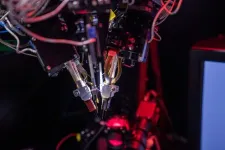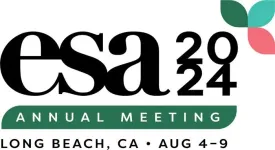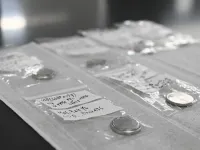(Press-News.org) Researchers at Queen Mary University of London have found that children living in areas with high levels of deprivation are three times more likely to have severe tooth decay that requires a dental extraction in hospital, compared with children living in more affluent areas. The findings highlight an urgent need for equitable access to preventive dentistry.
In the study, published today (16 July 2024) in BMJ Public Health, researchers analysed de-identified GP and hospital records for 600,000 children between the ages of five and 16 living in North East London. During the five-year study period, one in 200 children had at least one tooth removed under a general anaesthetic, which must be done in a hospital setting. Most of those children had multiple teeth extracted.
The study findings demonstrate major socioeconomic and ethnic inequalities in severe tooth decay in children, which is preventable through access to NHS dentists, and policies such as toothbrushing in schools and control of sugar in food and drinks.
Children living in areas with the highest proportion of low-income households were three times more likely to require a dental extraction, compared with those living in areas with the lowest proportion of low-income households.
Children from some ethnic groups were more likely to need a dental extraction, compared with children from White British ethnic groups:
White Irish: twice as likely;
Bangladeshi: 1.5 times more likely;
Pakistani: 1.4 times more likely.
Children living with obesity were less likely to require a dental extraction than children with healthy weight. More research is needed to replicate and understand this finding.
The researchers also examined the data by North East London borough, comparing rates of children’s dental extractions with access to NHS general dental practitioners. After adjusting for deprivation and ethnic group, the highest risk of hospital dental extraction was for children in Tower Hamlets, which also has the lowest general dental practitioner attendance in North East London. Conversely, children living in Redbridge, Havering, and Barking & Dagenham had the lowest risk of hospital dental extraction - these areas have the highest proportion of five-year-olds accessing general dental practitioner services. Additionally, the 2022 National Dental Epidemiology Programme (NDEP) oral health survey found that only 13% of decayed teeth in five-year-old children in London had been filled.
This study is the first to analyse inequalities in children’s tooth extractions under general anaesthesia by ethnic group in such granular detail, revealing a difference in outcomes between White Irish and White British groups, and between Bangladeshi, Pakistani and Indian groups. By linking hospital data to GP records, which include 16 categories for ethnic group, researchers were able to reveal ethnic inequalities that are less apparent when using the broader ethnicity categories used in previous research.
This research was funded by a grant from Barts Charity (ref: MGU0419).
Vanessa Muirhead, Co-author and Reader and Honorary Consultant in Dental Public Health at Queen Mary, said:
“Sadly, our findings demonstrate wide socioeconomic and ethnic inequalities related to access to dental care and outcomes.
“Tooth extraction is a last resort, but when families have difficulty accessing timely preventive and treatment services, dental problems can progress until children need more serious and costly interventions such as multiple tooth extractions under general anaesthesia.”
Nicola Firman, lead author and Health Data Scientist at Queen Mary, said:
“Linking health data from different settings has allowed us to see inequalities in the dental care system more clearly.
“Our findings point to an urgent need for equitable access to preventive general dental services, and interventions that are targeted at the wider determinants of dental health.”
Christopher Tredwin, Dean and Director of the Institute of Dentistry at Queen Mar, said:
“This research highlights clear oral health inequalities, which we are also acutely aware of through our longstanding service of the local community.
“In partnership with Barts Health NHS Trust, the Queen Mary Institute of Dentistry opened a new dental outreach clinic in Kenworthy Road, Homerton, earlier this year. It is now providing quicker and easier access to dental care in the local area, while our dental and therapy students learn to treat children in these primary care settings. Through the outstanding work of our students at these clinics, we hope to mitigate the effects of unequal access to general dentistry in North East London and help to provide care for those who need it most.”
Victoria King, Director of Funding and Impact at Barts Charity, said:
“This important work, supported by Barts Charity, has demonstrated that there are major inequalities linked to severe tooth decay for children in East London, which could be preventable. Supporting research to understand these health inequalities is key to making better healthcare possible for our diverse East London population."
END
Children living in deprived areas are three times more likely to need dental extractions in hospital
2024-07-16
ELSE PRESS RELEASES FROM THIS DATE:
Lowering systolic blood pressure below 120 mmHg may reduce dementia risk among Black, Latino populations
2024-07-16
FOR IMMEDIATE RELEASE
Monday, July 15, 2024
Contact:
Jillian McKoy, jpmckoy@bu.edu
Michael Saunders, msaunder@bu.edu
##
Lowering Systolic Blood Pressure below 120 mmHg May Reduce Dementia Risk Among Black, Latino Populations
A new study suggests that reducing systolic blood pressure below the clinically safe threshold of 120 mmHg over time may produce slight health-protective benefits against late-life dementia and help reduce racial and ethnic disparities in both hypertension and hypertension control.
Hypertension is one of the most modifiable risk factors for dementia, but most research on dementia risk reduction through blood ...
When to let Amazon sell for you
2024-07-16
AUSTIN, Texas — On Prime Day, Amazon shoppers will be able to browse over 600 million products. They may not be aware that most of those listings are from non-Amazon sellers, who account for 60% of sales on the platform. Most are small- and medium-sized businesses: bookstores selling used hardbacks, toymakers selling original goods, and distributors unloading clothes.
What shoppers also don’t see is the choice that the platform and the seller make about how to interact. Is it better ...
New OpenScope projects aim to pioneer the future of neuroscience
2024-07-16
By Jake Siegel
SEATTLE, WASH.—July 15, 2024—How do neurons react to magic mushrooms? What happens in the brain when we see motion, or when we recognize grain patterns in a piece of wood? How do our brains track the subtle changes in our friends’ appearances over time?
The Allen Institute has launched four projects to investigate these questions through OpenScope, a shared neuroscience observatory. Just as astronomers use a few well-equipped observatories to study the universe, the OpenScope program lets neuroscientists worldwide propose and direct experiments on the Allen Brain Observatory pipeline. ...
Silicon photonics light the way toward large-scale applications in quantum information
2024-07-15
In a significant leap forward for quantum technology, researchers have achieved a milestone in harnessing the frequency dimension within integrated photonics. This breakthrough not only promises advancements in quantum computing but also lays the groundwork for ultra-secure communications networks.
Integrated photonics, the manipulation of light within tiny circuits on silicon chips, has long held promise for quantum applications due to its scalability and compatibility with existing telecommunications infrastructure.
In a study published in Advanced Photonics, researchers from the Centre for Nanosciences and Nanotechnology (C2N), Télécom Paris, ...
Better together: spatial arrangement of three immune cells is key to attacking tumors
2024-07-15
There’s a frustrating fact about today’s immunotherapies for cancer. While sometimes they work beautifully — completely eliminating or greatly reducing cancer in particular patients — other times they don’t work at all. It’s a mystery.
Scientists have posed several hypotheses to explain the disparity. Perhaps it’s the number of mutations present in a tumor, with more mutations leading to better responses. Or maybe it’s the tissue environment surrounding the tumor, with some environments supporting and others suppressing effective immune responses. But so far, none of these ...
How a ‘social good’ firm is defined can impact its value creation and value capital
2024-07-15
Ventures that pursue both commercial and social value creation have grown in popularity in recent years, but a new study published in the Strategic Entrepreneurship Journal better defines four distinct types of social ventures. By training a business model lens on these social good ventures, the study offers insight on how the model choices impact a firm's value creation and value capture potential.
“Despite the popularity of the term ‘social entrepreneurship,’ not much was known about the business model of such companies yet,” says study co-author Lien De Cuyper of ...
American diets got briefly healthier, more diverse during COVID-19 pandemic
2024-07-15
UNIVERSITY PARK, Pa. — American diets may have gotten healthier and more diverse in the months following the start of the COVID-19 pandemic, according to a new study led by Penn State researchers.
The study — published in PLOS ONE — found that as states responded to the pandemic with school closures and other lockdown measures, citizens’ diet quality improved by up to 8.5% and food diversity improved by up to 2.6%.
Co-author Edward Jaenicke, professor of agricultural economics in the College ...
Media Tip Sheet: Symposia at ESA2024
2024-07-15
The latest ecological research will be on full display at the Ecological Society of America’s upcoming Annual Meeting in Long Beach, California, Aug. 4–9. A focal point of the conference, symposia consist of four 20-minute talks organized around a central theme of broad interest. These sessions consider topics from different angles, integrate multiple lines of evidence and offer new insights on ecological phenomena.
This year, Annual Meeting symposia will address nonmaterial (“cultural”) ecosystem services, nature-based solutions to problems like stormwater runoff and urban heat, ...
Making rechargeable batteries more sustainable with fully recyclable components
2024-07-15
UNIVERSITY PARK, Pa. — Rechargeable solid-state lithium batteries are an emerging technology that could someday power cell phones and laptops for days with a single charge. Offering significantly enhanced energy density, they are a safer alternative to the flammable lithium-ion batteries currently used in consumer electronics — but they are not environmentally friendly. Current recycling methods focus on the limited recovery of metals contained within the cathodes, while everything else goes to waste.
A team of Penn State researchers may have solved this issue. Led by Enrique Gomez, interim associate dean for equity and inclusion and professor of chemical engineering ...
Biodegradable electronics may advance with ability to control dissolve rate
2024-07-15
UNIVERSITY PARK, Pa. — Biodegradable electronics allow for medical devices — such as drug delivery systems, pacemakers or neural implants — to safely degrade into materials that are absorbed by the body after they are no longer needed. But if the water-soluble devices degrade too quickly, they cannot accomplish their purpose. Now, researchers have developed the ability to control the dissolve rate of these biodegradable electronics by experimenting with dissolvable elements, like inorganic fillers and polymers, that encapsulate the device.
The team, led by Huanyu “Larry” Cheng, the James L. Henderson, Jr. Memorial Associate Professor ...




